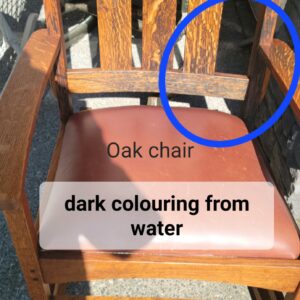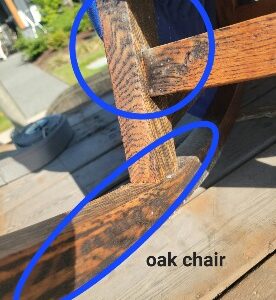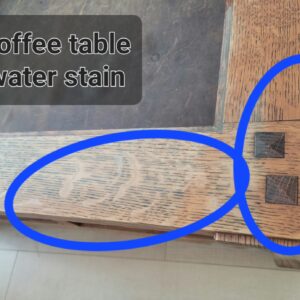Would love to hear your thoughts on this. This chair and coffee table were in storage for 2 1/2 years in a container that leaked. One of the rockers de-laminated but that’s an easy fix. But what do I do about the dark mould-stains?
I thought of stripping entirely with oxalic acid and refinishing. That’s a lot of work; is there a way to patch the repair and try to blend it back to look original?
Another thought was to ebonize with steel wool/vinegar (or another dye or stain?) If I did that would I still have to strip to bare wood?
The original finishes were aneline dyes, shellac and wax.
Thanks!
Rich


















Replies
I might sand and remove any adhered old finish. There are commercial cleaners available which are usually some kind of oxalic acid solution. So, 30 cents worth of oxalic acid for $30 but formulated in proper proportions. I don't like oxalic acid unless I'm trying to do something like turn black to white! I find that a hydrogen bleach like oxyclean works quite well. Chlorine bleach I would avoid because you need to neutralize and it might over do what your trying to achieve. Water stains in wood I've managed to remove with Murpheys Oil Soap a white terry towel and lots of elbow grease. Blue Dawn and baking soda as a paste and a stiff brush will clean anything,up to and including nuclear contamination!
You could ,after cleaning, stripping consider fuming. Get a commercial grade ammonia put it in a bowl and stuff your chair and the bowl inside a plastic garbage bag well away from where you breath. Is that an old { antique) chair? You know it's dyed, how? Mission oak like that was often fumed. And yes, if you want a consistent refinish your down to barewood. Old stuff is allowed to be patinaed and we call that beautiful...Or at least character! So repaired finishes even if they show and are less than grim I think are ok.
I just made a huge mistake. A teak table that I had stuffed away I was going to give to someone. The finish was a bit dawdy so I thought maybe I'd fix it a bit but didn't want it to be some big project. I had some " Restore a Finish " tested it on a leg. It looked OK so I did the legs and they looked pretty good when done . Then I did the top and that turned into this blotchy ugly mess so now I'm sanding down to bare wood and refinishing competely! Did I mention I'm giving the thing away? Never ever be tempted to use that product!
Thanks very much for this!
I like your idea of Murphy's or Dawn and soda--maybe as a first step to see what happens.My fear is that the open grain of the white oak has absorbed the staining deep into the wood.
I built both of these so I would like to get back to original as much as possible, but I do agree that some flaws in "old" finishes can just add character. Never tried fuming but the dyes I did used were intended to mimic fuming. Would I be right in saying that if I wanted to fume I would need to strip to bare wood?
(Sorry to hear of your table :(
Regarding stripping. I wouldn't use oxalic acid myself because then you need to get rid of it and its pretty irritating. I will sometimes use a stripper but only initially. Just enough to lift the surface and soften the finish. Avoiding letting the stripper making actual contact with the wood where possible. So, not too much. Then it's scrappers after that. Ist scrape the mess off, wash it off with mineral spirits then scrape and curse,scrape and curse!
If you don't completely remove the old finish you get variations. Absorption here ,non there. It can maybe look OK or an absolutely terrible repair and it's almost impossible to predict the result. Fuming over an old finish. I have doubts. You have an advantage. You know what was used originally and your not guessing.
Clean off the mold. Then strip and refinish. What you are proposing will require far more time, effort, and mess, and the results will be inferior.